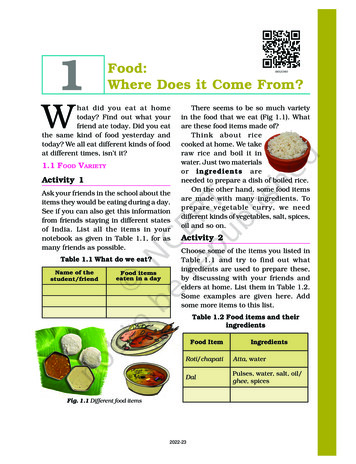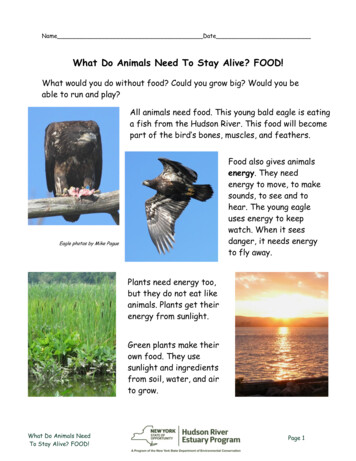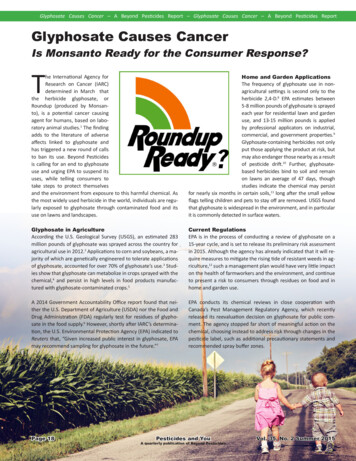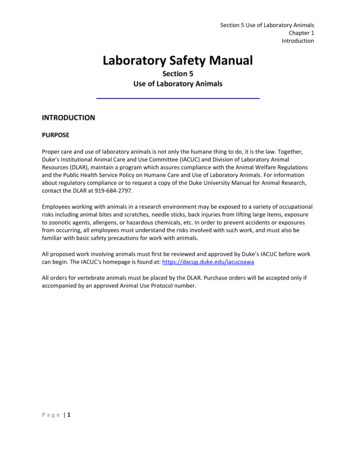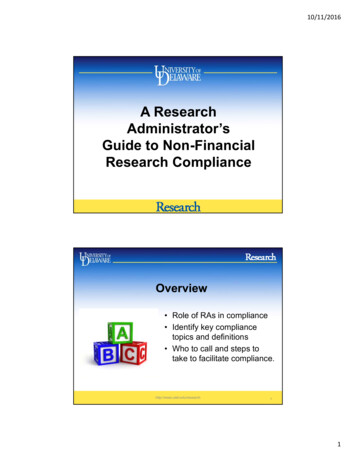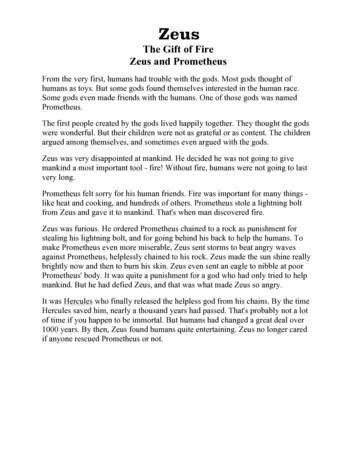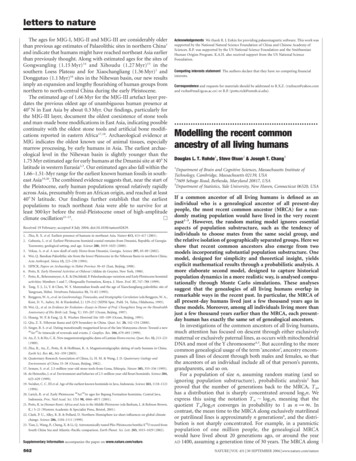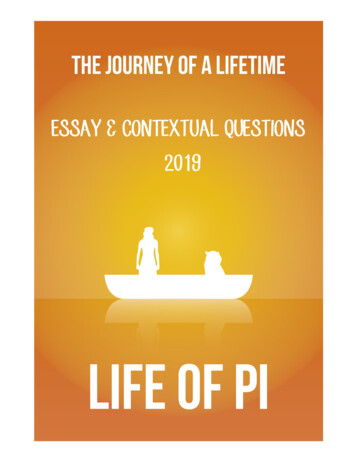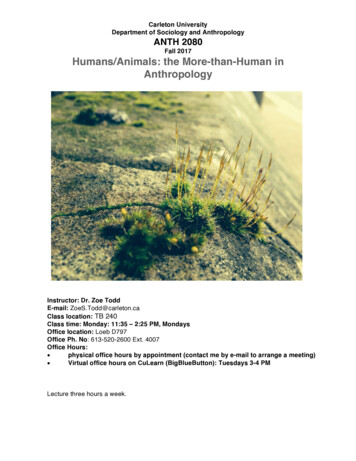
Transcription
Carleton UniversityDepartment of Sociology and AnthropologyANTH 2080Fall 2017Humans/Animals: the More-than-Human inAnthropologyInstructor: Dr. Zoe ToddE-mail: ZoeS.Todd@carleton.caClass location: TB 240Class time: Monday: 11:35 – 2:25 PM, MondaysOffice location: Loeb D797Office Ph. No: 613-520-2600 Ext. 4007Office Hours: physical office hours by appointment (contact me by e-mail to arrange a meeting) Virtual office hours on CuLearn (BigBlueButton): Tuesdays 3-4 PMLecture three hours a week.
ASSIGNMENTS- Reading Quiz (5%) (September 25)-quiz on readings up to and including those assigned for September 25 class.-Writing reflection 1: reflection on readings (500-750 words) (15%) (due at beginning of classon October 16)-students will be expected to reflect on readings completed up to this point in class (ie: readingsassigned from September 18 to October 16, inclusive). Assignment expectations will be furtheroutlined in class.-Writing reflection 2: reflection on readings (500-750 words) (15%) (due at beginning of classon November 6)-students will be expected to reflect on readings completed between October 30 and November 6,inclusive. Assignment expectations will be further outlined in class-OttawaRiver watershed more-than-human portfolio (20%) (tobe submitted November 20) students must prepare a portfolio/dossier on a specific animal, plant, geologic formation,micro-organism, insect (or other more-than-human being) that is found in the Ottawa Riverwatershed. You are expected to prepare this portfolio (ie: collect articles, photos, stories, and othersecondary sources) throughout the semester and deliver the final product with a 2 page precisoutlining what you have collected on this nonhuman and why you chose to learn more about it. Students will be asked to apply the anthropological methods, theories andapproaches studied in class to analyze, summarize and respond to this nonhumanbeing and why it is important to the Ottawa River watershed. Assignment expectations (timelines, rubric) will be further outlined in class (Topics to be confirmed in writing with instructor by October 30) (5%)-Participation: submission of weekly in-class one paragraph reflections (questions deliveredin-class, assignment written up in class) (10%)-Final Essay: (due at the beginning of class on 08 December): a final essay on ananthropology’s approach to human-animal relations/research (3000-5000 words) will be completed(30%) (topics should be finalized by November, and students are encouraged to meet with me todiscuss the essay throughout the term)
Calendar Description:Anthropology and the EnvironmentExamination of relationships between humans and animals in the anthropological canon,including: multispecies ethnography, the role of the ‘more than human’ in Indigenous legal orders,posthumanist and STS theory, relationships between humans and animals and othernon-human entities in the Anthropocene.I. Course Description and Objectives:This course will provide an overview of the relationship between humans and more-than-humanbeings, as understood in anthropology in the past and present. We will examine case studies ofhuman-animal and human-environmental relations and how anthropological methods and theorycan be used to understand and critically analyze these relationships. We will also consider critiquesof anthropology’s approach to human-nonhuman relations offered by Indigenouspeoples/scholars/thinkers/organizations; environmentalists; and a variety of other actors.The course material draws upon a range of sources, including materials from anthropology, Scienceand Technology Studies, Indigenous Studies, Geography and other disciplines. The aim of thecourse is to encourage students to be able to, in writing and in oral presentation work:a) identify historical and contemporary human/nonhuman relations as they are addressedwithin the North American (socio-cultural) anthropological canonb) become more familiar with the more-than-human constituents of the unceded AlgonquinTerritory the class takes place inc) analyze popular media and academic narratives of human/nonhuman issuesd) apply critical anthropological discourses to understanding a) relationships betweenhumans and more-than-humans and b) how these relationships are shaped by, andunderstood through, dynamic and diverse socio-cultural factors/lenses throughout theworldII. Course PoliciesCommunications:If you have questions about class readings and assignments, you can reach me by email atZoeS.Todd@carleton.ca, through the e-mail function in CuLearn, or by contacting me during officehours (which are noted above). I will try to answer all correspondence within 48 hours. I readand respond to emails between 9 AM to 5 PM on weekdays, and I do not check or answer emails on the weekend.(Do not contact Zoe.Todd@carleton.ca as this address belongs to a different person andyour e-mails will not reach me)For submission of assignments, please use the email function in CuLearn to submit electroniccopies of course materials to me (in addition to the hard copies you will submit in class). I will sendout correspondence to the class (re: assignments, readings) through CuLearn. I stronglyrecommend that students use CuLearn email for course correspondence with me and your fellowclassmates—this will ensure that if something does not get through to me, there is a record of yourcorrespondence saved in CuLearn.
Class Conduct:The materials covered in this course will engage a range of complex topics. It is important thatthese issues be addressed collectively within the class in a sensitive, respectful and accountablemanner.Assignment Submission:Course assignments shall be submitted to me in hard copy in class on the date it is due, ANDyou must submit an electronic copy of all assignments through email atZoeS.Todd@carleton.ca (if file is too large to upload to the email, then you may use email me a linkto your assignment sent via a file transfer program such as WeTransfer.com or Dropbox). Pleaseretain a copy of all assignments—if one of your assignments is not received by me because it islost, misplaced or otherwise goes missing, you will be responsible for submitting a backup copyimmediately upon request. Do not submit assignments under my door. Quizzes and other in-courseassignments will be returned in class, and assessments will also be returned in class. Finalassignments (essay) will be available for pick up from my office once they are marked.There is a 5% penalty for each day that an assignment is late.III. Texts:Required Texts:Haraway, Donna. 2008. When Species Meet. University of Minnesota Press.ISBN-13: 978-0816650460Kimmerer, Robin Wall. (2013). Braiding Sweetgrass: Indigenous Wisdom, ScientificKnowledge, and Teachings of Plants. Milkweed Editions.ISBN 978-1-57131-356-0These texts are both available for order via Amazon.--a copy of the required textbook has been placed on reserve at MacOdrum Library--other course readings (articles) will be made available electronically through CuLearn (we will goover how to access these on the first day of class)
IV. Course calendar:Class Schedule:1. September 11 – Introduction to the course, ‘what is the more-than-human?’ Discussion of syllabus and expectations Viewing of first half of the the documentary Birds of a Feather.2. September 18 - human-nonhuman relations and anthropology, an introductionReadings to be done before class: Braiding Sweetgrass--Chapter 1: “Planting Sweetgrass” (pp. 3-48) When Species Meet – Chapter 1: “Introduction” (pp. 3-45)3. September 25 –Nature/Culture: where does the more-than-human reside? READING QUIZ Braiding Sweetgrass--Chapter 2 “Tending Sweetgrass” (pp. 49-71)When Species Meet – Chapter 2 “Value Added Dogs and Lively Capital) (pp. 45-68)Descola, Phillippe. 2009. Chapter 2: “The Wild and the Domesticated”, pp. 32-53 inBeyond Nature and Culture, Chicago: University of Chicago Press).4. October 2 – Multispecies ethnography: where do species meet in anthropology? Braiding Sweetgrass—Chapter 2, continued “Tending Sweetgrass” (pp. 72-105) When Species Meet – Chapter 3 “Sharing Suffering” (pp. 69-94) Kirksey, E and S. Helmreich. 2010. “The Emergence of Multispecies -the-emergence-of-multispecies-ethnography Myers, Natasha. 2017. (2017) ‘From the Anthropocene to the Planthroposcene: DesigningGardens for Plant/People Involution,’ History and Anthropology 28 (30): 297-301.5. October 9 (No class – Thanksgiving)6. October 16 – More-than-human relations I: Rocks, glaciers and geologicsREADING REFLECTION ASSIGNMENT DUE AT THE BEGINNING OF CLASS Cruikshank, Julie. (2005). Do Glaciers Listen?: Local knowledge, Colonial encounters, andSocial imagination. Vancouver: UBC Press, pp. 55-75 Povinelli, Elizabeth. 2015. Chapter 3: “The Fossil and the Bones” Pp. 57-91 inGeontologies, Duke University Press.7. October 23 – Fall Break8. October 30 More-than-human relations II: Indigenous cosmologies and the more-thanhuman Braiding Sweetgrass, Chapter 3, “Picking Sweetgrass” (pp. 106-174) Baldy, Cutcha Risling. 2014. Coyote is Not a Metaphor: On decolonizing, (re)claiming and(re)naming “Coyote”. DIES: Decolonization, Indigeneity and Society le/view/221559. November 6 – Animal Rights, Indigenous RightsREADING REFLECTION ASSIGNMENT DUE AT THE BEGINNING OF CLASS Braiding Sweetgrass, Chapter 3, “Picking Sweetgrass” (pp. 175-204) When Species Meet: Chapter 4, “Friends, Foes, and Fashion Statements” (pp. 97-128)
Wenzel, George. (1991) “Animal rights, the seal protest and the Inuit”, pp. 35-55 in AnimalRights, Human Rights: Ecology, Economy, and Ideology in the Canadian Arctic. Toronto:University of Toronto Press.In Class Viewing of Angry Inuk by Alethea Arnaquq-Baril10. November 13 – Wildlife conservation and Traditional Ecological Knowledge Braiding Sweetgrass, Chapter 4, “Braiding Sweetgrass” (pp.205-240) When Species Meet Chapter 5: “Cloning Mutts, Saving Tigers: Bioethical Angst andQuestions of Flourishing” (pp. 133-160) Nadasdy, Paul. 2005. The Anti-Politics of TEK: The Institutionalization of Co-managementand Discourse and Practice. Anthropologica 47 (2005): 215-232.https://www.jstor.org/stable/25606237?seq 1#page scan tab contents11. November 20 – Decolonizing multispecies ethnography/posthumanism I: who isPosthumanism written for? Black and Indigenous feminist critiques of posthumanismOTTAWA RIVER WATERSHED NONHUMAN PORTFOLIO ASSIGNMENT DUE AT THEBEGINNING OF CLASSBraiding Sweetgrass, Chapter 4, “Braiding Sweetgrass” (pp.241-302) Jackson, Zakiyyah Iman. 2013. Animal: New Directions in the Theorization of Race andPosthumanism. Feminist Studies 39(3): 669-685) Watts, Vanessa. 2013. Indigenous Place‐Thought and Agency amongst Human And Non-‐humans (First Woman and Sky Woman go on a European Tour!). DIES: Decolonization,Indigeneity, Education and Society 2(1): ownload/19145/16234)12. November 27 – Decolonizing multispecies ethnography/posthumanism II:atmospheres/climate as nonhuman agents Braiding Sweetgrass, Chapter 5, “Burning Sweetgrass” (pp.303-340) Sharpe, Christina. 2016. “The Weather”, Chapter 4 (pp. 102-134) in In the Wake: OnBlackness and Being. Duke University Press. Qitsualik, Rachel. 1998. “Word and Will—Part Two: Words and the Substanceof Life." Nunatsiaq News November 12, 1998. Accessed 27 September2015: 30/nvt81113 09.html14. December 4 – toxic more-than-humanisms Braiding Sweetgrass, Chapter 5, “Burning Sweetgrass” (pp.341-379) Braiding Sweetgrass, Epilogue: Returning the Gift (pp.380-385) Fortun, Kim. 2014. From Latour to late industrialism. HAU le/view/hau4.1.017/661 Davis, Heather. 2016. [video] The Queer Futurity of Plastic. Talk, De Brakke Grond,Amsterdam, the Netherlands: https://vimeo.com/158044006 Todd, Zoe. 2017. Fish, Kin and Hope: tending to metis legal traditions in the NorthSaskatchewan River. Afterall: A Journal of Contemporary Art Theory 4315. FRIDAY December 8 Last ClassFinal Assignments Due at beginning of class.V. Evaluation:
For all assignments, citation and style guide is up to the student (ie: you may choose from APA,MLA, or Chicago) but pick one style and stick with it. Carleton Library has excellent resources onstyle guides here: ourcesI strongly recommend taking advantage of writing tutorial services offered by the rading rubric:From the University gsuniv2/“2.3 Standing in Courses/Grading SystemStanding in a course is determined by the course instructor, subject to the approval of the facultyDean. Standing in courses will be shown by alphabetical grades. The system of grades used, withcorresponding grade points is:A AAB B12111098BC CCD 76543DDF21Grade points indicated above are for courses with 1.0 credit value. Where the course credit isgreater or less than one credit, the grade points are adjusted proportionately.The following percentage equivalents apply to all final grades at Carleton:A AAB B90-10085-8980-8477-7973-76BC CCD 70-7267-6963-6660-6257-59DDF53-5650-520-49Other grades and notations in current use by the university are as follows:FFailure. The grade of F is assigned when the student has failed to meet the conditionsof “satisfactory performance” defined in the Course Outline. F carries 0.0 grade points.”"Standing in a course is determined by the course instructor subject to the approval of theFaculty Dean. This means that grades submitted by the instructor may be subject to revision.No grades are final until they have been approved by the Dean."VI. Statement on PlagiarismPLAGIARISMThe University Senate defines plagiarism as “presenting, whether intentionally or not, theideas, expression of ideas or work of others as one’s own.” This can include:
oreproducing or paraphrasing portions of someone else’s published orunpublished material, regardless of the source, and presenting these as one’sown without proper citation or reference to the original source;osubmitting a take-home examination, essay, laboratory report or otherassignment written, in whole or in part, by someone else;ousing ideas or direct, verbatim quotations, or paraphrased material, concepts,or ideas without appropriate acknowledgment in any academic assignment;ousing another’s data or research findings;ofailing to acknowledge sources through the use of proper citations when usinganother’s works and/or failing to use quotation marks;ohanding in "substantially the same piece of work for academic credit morethan once without prior written permission of the course instructor in which thesubmission occurs."Plagiarism is a serious offence which cannot be resolved directly with the course’s instructor.The Associate Dean of the Faculty conducts a rigorous investigation, including an interviewwith the student, when an instructor suspects a piece of work has been plagiarized. Penaltiesare not trivial. They can include a final grade of "F" for the course.VII. Requests for Academic Accommodations“Academic AccommodationYou may need special arrangements to meet your academic obligations during the term. Foran accommodation request the processes are as follows:Pregnancy obligation: write to me with any requests for academic accommodation duringthe first two weeks of class, or as soon as possible after the need for accommodation isknown to exist. For more details see the Student Guide nt-Guide-to-Academic-Accommodation.pdf)Religious obligation: write to me with any requests for academic accommodation during thefirst two weeks of class, or as soon as possible after the need for accommodation is known toexist. For more details see the Student Guide nt-Guide-to-Academic-Accommodation.pdf)Academic Accommodations for Students with Disabilities: The Paul Menton Centre forStudents with Disabilities (PMC) provides services to students with Learning Disabilities (LD),psychiatric/mental health disabilities, Attention Deficit Hyperactivity Disorder (ADHD), AutismSpectrum Disorders (ASD), chronic medical conditions, and impairments in mobility, hearing,and vision. If you have a disability requiring academic accommodations in this course, pleasecontact PMC at 613-520-6608 or pmc@carleton.ca for a formal evaluation. If you arealready registered with the PMC, contact your PMC coordinator to send me your Letter ofAccommodation at the beginning of the term, and no later than two weeks before the first inclass scheduled test or exam requiring accommodation (if applicable). After requestingaccommodation from PMC, meet with me to ensure accommodation arrangements aremade. The deadline for contacting the PMC regarding accomodation for final exams for theFall exam period if November 10, 2017.
Braiding Sweetgrass, Chapter 4, "Braiding Sweetgrass" (pp.205-240) When Species Meet Chapter 5: "Cloning Mutts, Saving Tigers: Bioethical Angst and Questions of Flourishing" (pp. 133-160) Nadasdy, Paul. 2005. The Anti-Politics of TEK: The Institutionalization of Co-management and Discourse and Practice.


